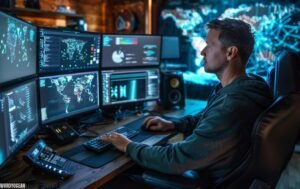Unstability AI 862 5790522 NJ: Unraveling the Mystery

Have you ever stumbled upon an image so surreal, so otherworldly, that it left you questioning its origins? If so, you’ve likely encountered the enigmatic realm of AI-generated art. At the heart of this digital renaissance lies a specific image, “unstability ai 862 5790522 nj,” a captivating piece that has sparked curiosity and debate among art enthusiasts and technology aficionados alike.
In this exploration, we will delve into the mysterious world of AI-generated images, specifically examining the intriguing case of “unstability ai 862 5790522 nj.” We will uncover the underlying technology, discuss its implications, and speculate on the future of AI-powered creativity.
AI image generation is a revolutionary technology that empowers machines to create stunning visual art. By training neural networks on vast datasets of images and text, AI models can learn to generate new images that are both realistic and imaginative. These models, such as Stable Diffusion, Midjourney, and DALL-E 2, have the ability to transform simple text prompts into breathtaking visual masterpieces.
The Enigma of “unstability ai 862 5790522 nj”
At the heart of this digital renaissance lies a specific image, “unstability ai 862 5790522 nj,” a captivating piece that has sparked curiosity and debate among art enthusiasts and technology aficionados alike. This enigmatic image, generated by an AI model known as “unstability AI,” offers a glimpse into the future of creative expression.
What is “unstability ai 862 5790522 nj”?
AI-generated images are created through a complex process involving artificial neural networks. These networks are trained on vast datasets of images and text, allowing them to learn the underlying patterns and relationships between visual and textual information. Once trained, these models can generate new images based on specific prompts or parameters.
“unstability ai 862 5790522 nj” is a prime example of the capabilities of AI image generation. This particular image is characterized by its surreal and dreamlike quality, featuring intricate patterns, vibrant colors, and otherworldly landscapes. The image’s unique characteristics have led to a variety of interpretations, from abstract art to cosmic visions.
The Role of AI Models in Image Generation
AI models like Stable Diffusion, Midjourney, and DALL-E 2 play a crucial role in the creation of AI-generated images. These models are trained on massive datasets of images and text, enabling them to learn the nuances of visual and textual representation. By analyzing this vast amount of data, the models can identify patterns, trends, and stylistic elements that can be used to generate new images.
One of the most fascinating aspects of AI image generation is the role of prompts and parameters. By providing specific prompts, such as “a futuristic cityscape” or “a whimsical fairy tale,” users can guide the AI’s creative process. Additionally, by adjusting various parameters, such as image resolution, style, and level of detail, users can further customize the generated images.
Deeper Dive into the Image’s Implications
Potential Applications
The emergence of AI-generated images has opened up a world of possibilities across various industries. In the realm of creative arts and design, AI can assist artists in generating unique and innovative concepts, from digital paintings to architectural designs. Gaming and virtual reality industries can leverage AI to create immersive and dynamic environments, transporting players to fantastical realms.
AI-generated images also have significant potential in marketing and advertising. By crafting visually appealing and attention-grabbing content, businesses can enhance brand recognition and drive customer engagement. Additionally, AI can be used to generate personalized product recommendations and marketing campaigns, tailoring experiences to individual preferences.
In the field of scientific research and education, AI-generated images can be used to visualize complex data, making it easier to understand and interpret. For instance, AI can generate realistic visualizations of molecular structures or simulate the effects of climate change.
Ethical Considerations
While AI-generated images offer immense potential, it is essential to consider the ethical implications of this technology. One major concern is the potential for misinformation and deepfakes. Malicious actors could use AI to create highly realistic but false images, leading to widespread confusion and deception.
Copyright and intellectual property rights also pose challenges in the context of AI-generated art. As AI models are trained on vast datasets of copyrighted images, questions arise about the ownership of the generated content. Striking a balance between protecting creators’ rights and encouraging innovation is crucial.
Furthermore, AI models can inadvertently perpetuate biases present in their training data. This can lead to the generation of biased or discriminatory images, reinforcing harmful stereotypes. It is imperative to develop AI models that are fair, unbiased, and inclusive.
The Future of AI Image Generation
The future of AI image generation is undoubtedly bright, with exciting advancements on the horizon. We can expect to see even more sophisticated and realistic AI-generated images, blurring the lines between artificial and human-created art. However, as AI technology continues to evolve, it is essential to address the ethical challenges and ensure that it is used responsibly.
By fostering collaboration between technologists, artists, ethicists, and policymakers, we can harness the power of AI to create a future where technology and creativity coexist harmoniously.
Conclusion
In conclusion, the enigmatic image “unstability ai 862 5790522 nj” offers a fascinating glimpse into the capabilities of AI-powered creativity. By understanding the underlying technology and its potential applications, we can appreciate the immense potential of AI image generation.
However, it is crucial to approach this technology with a critical eye, considering the ethical implications and potential pitfalls. By fostering responsible AI development and promoting ethical guidelines, we can ensure that AI is used to benefit society and avoid unintended consequences.
As we venture into the future, the boundaries of AI-generated art will continue to expand. We can anticipate even more stunning and innovative creations that challenge our perceptions of reality. By embracing the power of AI and nurturing human creativity, we can unlock a new era of artistic expression and technological advancement.
So, the next time you encounter an AI-generated image, take a moment to appreciate the intricate interplay of technology and imagination. After all, the future of art may be more AI-powered than we ever imagined.
FAQ’s
Q: What is “unstability ai 862 5790522 nj”?
A: “unstability ai 862 5790522 nj” is a specific AI-generated image that showcases the capabilities of AI models like Stable Diffusion, Midjourney, and DALL-E 2. These models can generate unique and imaginative images based on text prompts and parameters.
Q: How are AI-generated images created?
A: AI-generated images are created through a complex process involving artificial neural networks. These networks are trained on vast datasets of images and text, allowing them to learn patterns and relationships between visual and textual information. Once trained, the models can generate new images based on specific prompts or parameters.
Q: What are the potential applications of AI-generated images?
A: AI-generated images have a wide range of applications, including creative arts and design, gaming and virtual reality, marketing and advertising, and scientific research and education. They can be used to generate unique art pieces, immersive gaming experiences, visually appealing advertisements, and data visualizations.
Q: What are the ethical considerations of AI-generated images?
A: The ethical implications of AI-generated images include the potential for misinformation and deepfakes, copyright and intellectual property issues, and bias and discrimination in AI models. It is crucial to address these concerns to ensure the responsible and ethical use of AI.








